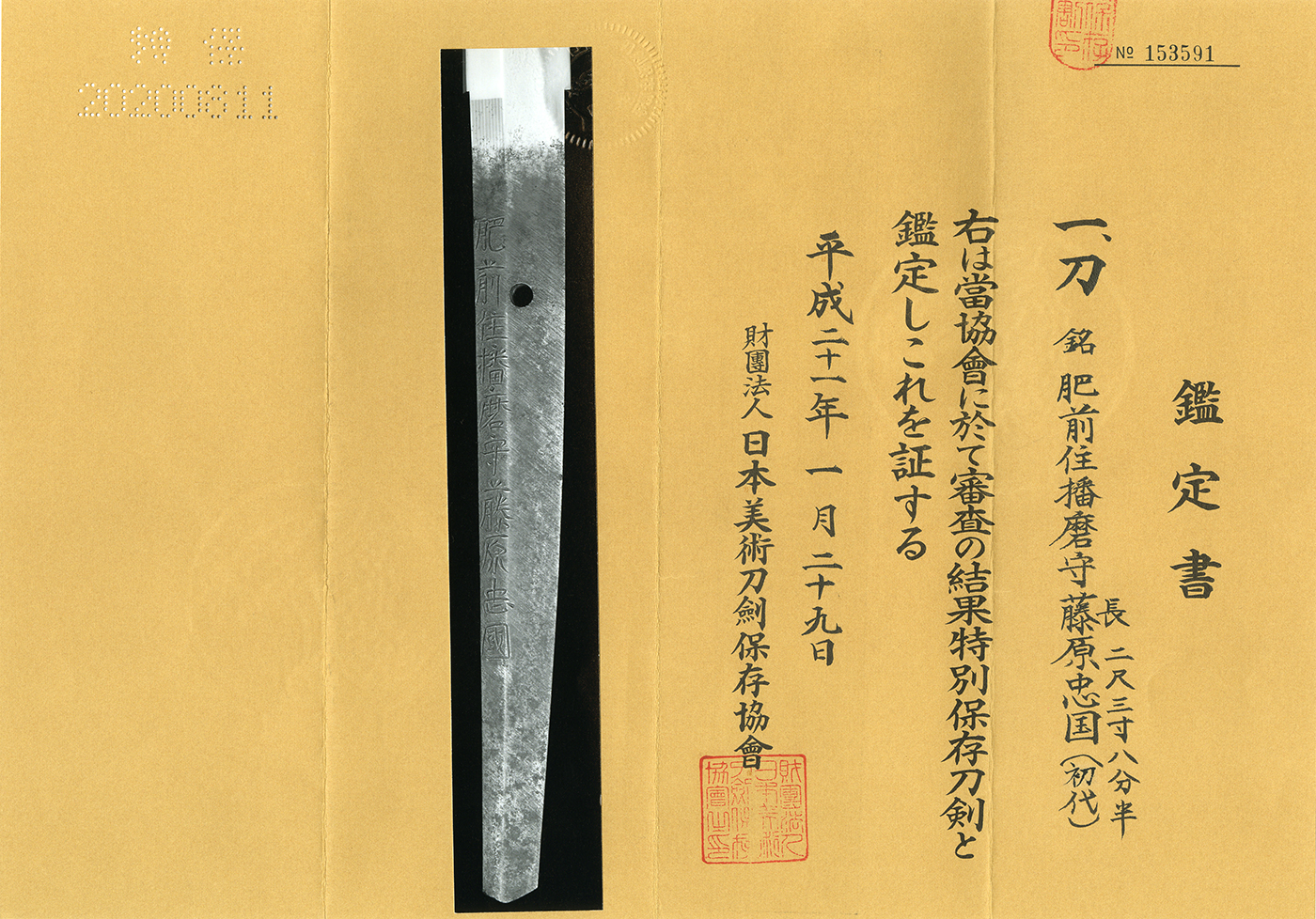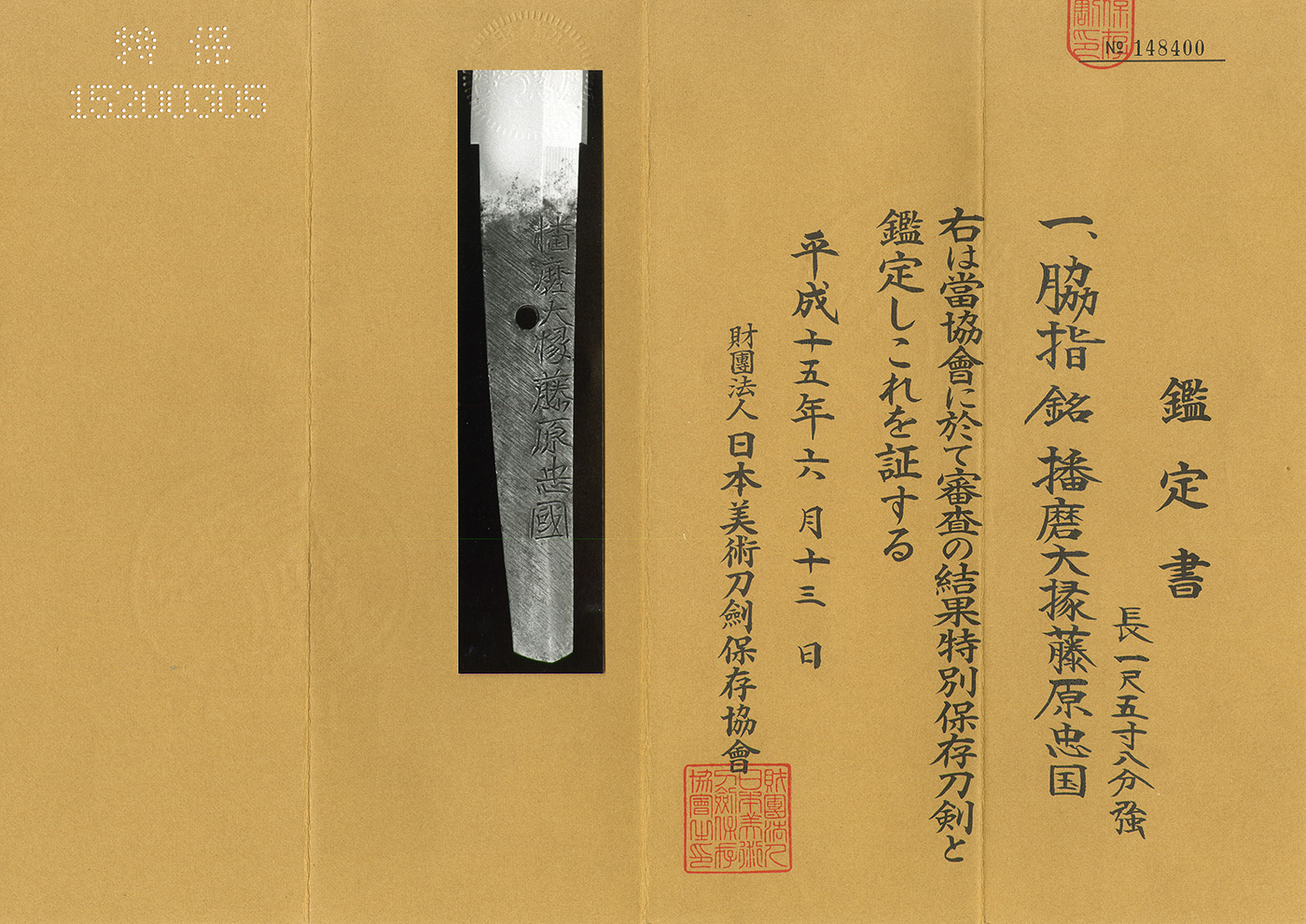Description
Ordering numbwer:AS15833
Dai Sho :
———————
Dai : Katana in Shirasaya with Koshirae(NBTHK Tokubetsu Hozon Token)
Signature: Hizen Kuni Ju Harima Kami Fujiwara Tadakuni (1st)
肥前國住播磨守藤原忠國(初代)
(We divide 4 sections for each sword as Saijyo saku, Jyojyo saku
Jyo saku and regular saku)
This blade belongs to Jyo Jyo saku ranking.
Habaki: Made of copper with gold inlay.
Blade Length: 2 shaku 3 sun 8 bu (72.1 cm / 28.39 in).
Curvature: 5 bu 5 rin (1.6 cm / 0.63 in).
Mekugi Hole: 1.
Width at Base (Motohaba): 2.95 cm (1.16 in).
Width at Tip (Sakihaba): 2.06 cm (0.81 in).
Thickness (Kasane): 0.74 cm (0.29 in).
Sword Weight: 810 g (1.79 lbs).
Era: Early Edo period, around the Kan’ei era (1624–1644).
Shape: A well-balanced sword with standard width and thickness.
Jigane: Ko itame-hada, well-forged with refined and excellent jigane.
Hamon: Gunome-midare with tama-yaki, featuring activities such as sunagashi and kinsuji in the blade, with a round return at the boshi.
Features: Harima Daijo Fujiwara Tadakuni was a swordsmith from Hizen province. The first-generation Tadakuni was a student of the first-generation Tadayoshi. He created remarkable works in both suguha (straight) and midareba (irregular) patterns.
This piece exhibits a beautiful and varied gunome-midare hamonand well-balanced body showcasing exceptional craftsmanship.
Koshirae:
Tsuba: Made of plain copper, carved with arabesque design and Ichimonji Mitsuboshi crest.
The rim is covered with brass.
All Fittings: Made of brass, engraved with arabesque design, Mitsuhiki crest, and Ichimonji Mitsuboshi crest.
The pommel (Kashira) and the end cap of the scabbard (Kojiri) are decorated with chrysanthemum motifs.
Tsuka / Saya: Decorated with gold nashiji lacquer and gold maki-e of dragonflies, butterflies, bamboo, and Mitsuhiki crest.
Menuki: Made of brass, carved with arabesque design and Ichimonji Mitsuboshi crest.
———————
Sho : Wakizashi in Shirasaya with Koshirae(NBTHK Tokubetsu Hozon Token)
Signature : Harima Kami Fujiwara Tadakuni
播磨大掾藤原忠国
(We divide 4 sections for each sword as Saijyo saku, Jyojyo saku
Jyo saku and regular saku)
This blade belongs to Jyojyo saku ranking.
Habaki: Single-layered gold-covered habaki
Blade Length: 48.0 cm (18.90 in)
Curvature: 1.0 cm (0.39 in)
Mekugi Hole: 1
Width at Base (Motohaba): 3.12 cm (1.23 in)
Width at Tip (Sakihaba): 2.27 cm (0.89 in)
Thickness of Rim (Kasane): 0.68 cm (0.27 in)
Sword Weight: 515 grams
Era: Edo period, around the Kanbun era (1661–1673)
Shape:The blade has a wide body, slightly thick kasane, with curvature and an extended kissaki.
Jigane:Well-forged ko-itame hada, forming typical Hizen jigane.
Hamon:A nioi-based suguha with gunome-midare pattern.
The hamon is formed with nie, resulting in a gunome-midare pattern.
The boshi has deep nioi, is rounded, and turns back.
Features: Harima Daijo Fujiwara Tadakuni is known for gunome-midare hamon in nie-deki, with deep nioi, showing strong resemblance to works by the first and second generation Masahiro.
Tadakuni was the son of Yoshie from Hizen and bore the family name Hashimoto.
He was active from the Kanei era through Kanbun.
The sword evokes the summer atmosphere, reminiscent of lightning flashing through towering cumulonimbus clouds against a deep blue summer sky.
Koshirae:
Tsuba: Made of plain copper, carved with arabesque design and Ichimonji Mitsuboshi crest.
The rim is covered with brass.
All Fittings: Made of brass, engraved with arabesque design, Mitsuhiki crest, and Ichimonji Mitsuboshi crest.
The pommel (Kashira) and the end cap of the scabbard (Kojiri) are decorated with chrysanthemum motifs.
Tsuka / Saya: Decorated with gold nashiji lacquer and gold maki-e of dragonflies, butterflies, bamboo, and Mitsuhiki crest.
Menuki: Made of brass, carved with arabesque design and Ichimonji Mitsuboshi crest.
Kozuka: Made of brass, engraved with waves and plovers (chidori), and inlaid with shibuichi and suaka (copper and its alloys).
Comes with a small utility knife (Kogatana).
———————
Aoi Art’s Comment: The hamon of Harima Daijo Fujiwara Tadakuni, who was active alongside Kawachi Daijo and Kawachi no Kami Masahiro, is in my opinion highly worthy of greater recognition, and I hope everyone will take this into serious consideration.
This daisho set comes with an exceptional matching koshirae for both long and short swords.
The family crests of Mitsuhiki-ryo and Mitsuboshi Ichimonji are engraved respectively.
The Mitsuhiki-ryo crest was primarily used by the Date, Miura, Ashina, and Sakuma clans, while the Mitsuboshi Ichimonji crest is well-known as the kamon of the Mori and Watanabe clans.
Although the exact provenance of this set is unknown, it is highly likely that it once belonged to a daimyo family.
Katana: NBTHK Tokubetsu Hozon Token
Wakizashi: NBTHK Tokubetsu Hozon Token
certificate.Aoi Art estimation paper : whole Oshigata.











 日本語
日本語








